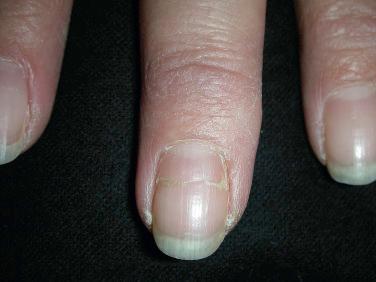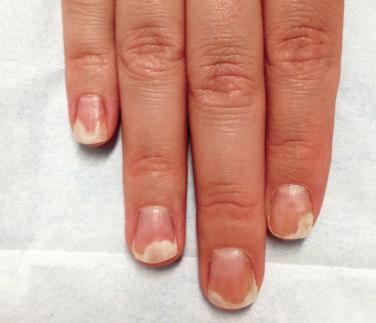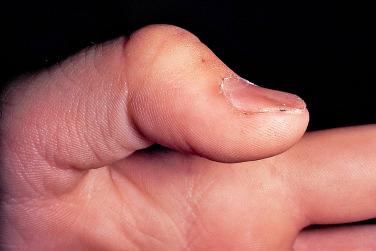Physical Address
304 North Cardinal St.
Dorchester Center, MA 02124
A complete and detailed history and physical examination of all 20 nails is essential in evaluating patients with suspected manifestations of systemic disease.
Subacute bacterial endocarditis is the most common systemic cause of splinter hemorrhages, which occur proximally and are typically present in multiple nails.
Muehrcke lines, half-and-half nails, and Terry nails are all examples of apparent leukonychia, in which there is abnormal nail bed vasculature, thereby changing the translucency of the nail plate. On physical exam, the whiteness disappears with pressure and is unaffected by nail growth.
Yellow nail syndrome is characterized by the triad of yellow nails, lymphedema, and respiratory tract involvement. Nails are thick and yellow, with an increased transverse curvature, absent cuticles, and slow growth rate.
The nails are unique from other appendages in that they often offer a glimpse into systemic conditions. Therefore, a fundamental understanding of nail unit anatomy is essential to appreciate nail abnormalities and their relationship to systemic diseases ( Fig. 44-1 ). The nail apparatus is composed of a hard and durable nail plate that lies above the nail bed and the distal portion of the nail matrix, which is seen distally as the white “half-moon”-shaped area known as the lunula. The remaining part of the matrix lies below the proximal nail fold. The undersurface of the proximal nail fold forms the eponychium (cuticle). The nail bed lies beneath the nail plate and above the distal phalanx. Due to its rich blood supply, the nail bed appears as a reddish area extending from the lunula to the area just proximal to the free edge of the nail. The proximal and lateral nail folds border the nail plate, and the hyponychium is the area under the free edge and the distal portion of the nail plate. The blood supply to the nail arises from the superficial and deep palmar branches of the digital arteries.
The nail plate is hard and durable due to its composition of keratins and sulfur, the latter in the form of cysteine. The mitotically active nail matrix forms the nail plate keratin. The proximal third of the matrix forms the upper third of the nail plate; the middle part of the matrix, the midportion; and the distal third of the matrix gives rise to the lower third of the plate. Therefore, by using knowledge of this anatomy, melanin in the nail plate may be traced back to its origin in either the distal or proximal matrix to guide an appropriate biopsy if necessary.
A complete and detailed history and physical examination of all 20 nails is essential in evaluating patients with suspected manifestations of systemic disease. While some nail findings may be characteristic of certain diseases, others may narrow the differential diagnosis, allowing an appropriate work-up to be initiated.
| Nail Condition | Description | Causes/Associated Disease States |
|---|---|---|
| Anonychia/Micronychia | Total or partial absence of nail | Trauma; bullous diseases; idiopathic atrophy of the nails; psoriasiform acral dermatitis; ischemia; nail–patella syndrome; epidermolysis bullosa; ectodermal dysplasias; DOOR syndrome; Iso–Kikuchy syndrome |
| Beau lines | Transverse grooves in nail plate | Nonspecific; acute infection or other metabolic insult; renal failure; myocardial infarction; epilepsy; reflex sympathetic dystrophy or brachial plexopathy (unilateral); deep sea diving/mountain climbing; Heimler syndrome; Guillain–Barré syndrome; local trauma; paronychia; chemotherapy; rheumatic fever; malaria; pemphigus; Raynaud’s phenomenon |
| Brittle nails (fragilitas unguium) | Roughness of nail plate, fragility of distal nail, splitting, peeling | Idiopathic; brittle nail syndrome; nutritional deficiency; thyroid dysfunction; glucagonoma; diabetes mellitus; trichothiodystrophy; drugs; trauma; arterial insufficiency; Raynaud’s phenomenon; renal failure; ectodermal dysplasias; deposition disorders (gout, amyloidosis, etc.); osteoporosis; tuberculosis; bronchiectasis; hypopituitarism; sarcoidosis |
| Bywater’s lesions | Hemorrhage/infarct of the nail folds | Rheumatoid arthritis-associated vasculitis |
| Clubbing | Loss of Lovibond’s angle (angle between nail plate and proximal nail fold) | Nonspecific; idiopathic; hereditary; cardiac; pulmonary; gastrointestinal; renal; endocrine; vascular abnormality (aneurysm, fistula, shunt); lymphadenitis; Pancoast tumor; reflex sympathetic dystrophy (unilateral); erythromelalgia; acquired hypertrophic pulmonary osteoarthropathy |
| Koilonychia | Spoon-shaped nails | Idiopathic; hereditary (autosomal dominant); iron deficiency anemia; fungal infection; psoriasis; high altitude; trichothiodystrophy; Raynaud’s phenomenon/ischemia; trauma; liver disease; gastrointestinal malignancies; normal children; infants (temporarily); porphyria; hemochromatosis; occupational |
| Leukonychia | White discoloration of nails (true or apparent) | True leukonychia (nail plate): zinc deficiency; trauma; chemotherapy; congestive heart failure; altitude changes (increase); infection; diabetes; lymphoma; Heimler’s syndrome Apparent leukonychia (nail bed): see Lindsay nails (half-and-half nails); Terry nails; Muehrcke nails; renal; hypoalbuminemia |
| Lindsay nails/half-and-half nails | White discoloration of proximal half of nail bed, with reddish brown band distally; blanches with pressure | Chronic renal failure; Crohn’s disease; Kawasaki disease; cirrhosis; zinc deficiency; chemotherapy; Behçet’s disease; pellagra |
| Lunular color changes | Blue or red lunula | Blue—Wilson’s disease; argyria; cyanosis; hereditary benign telangiectasia Red—congestive heart failure; emphysema; chronic obstructive pulmonary disease; chronic bronchitis; carbon monoxide poisoning; systemic lupus erythematosus; alopecia areata; vitiligo; lichen sclerosus; rheumatoid arthritis; psoriasis |
| Mees lines (Aldrich–Mees lines) | Transverse white bands (usually multiple nails) that grow out with nail plate; unaffected by pressure | Arsenic, thallium, or other heavy metal poisoning; infection; acute renal failure; congestive heart failure; ulcerative colitis; breast cancer; systemic lupus erythematosus |
| Melanonychia (longitudinal pigmented bands) | Vertical bands of brown or black pigment of the nail plate | Benign melanocytic activation; lentigines; nevi; Laugier–Hunziker syndrome; infection; PUVA therapy; Addison’s disease; following adrenalectomy for Cushing’s disease; drugs; exogenous pigment; endocrine disorders; trauma; medications; tumors—squamous cell carcinoma, melanoma (Hutchinson’s sign = pigment involvement of proximal nail fold, worrisome for melanoma) |
| Muehrcke lines | Multiple (usually double) transverse white bands, parallel to lunula; unaffected by nail growth, blanch with pressure | Hypoalbuminemia; nephrotic syndrome; postcardiac transplantation; cardiomyopathy; ACTH-dependent Cushing’s; Peutz–Jeghers syndrome with hepatic adenoma; chemotherapy; liver disease; malnutrition; HIV/AIDS |
| Proximal nail fold capillary abnormalities | Distortion of normal capillary architecture | Avascular portions with dilated capillary loops: systemic sclerosis; dermatomyositis Normal vascular density with tortuous capillaries: systemic lupus erythematosus |
| Onychocryptosis | Ingrown nail | Trauma; neglect; older age; highly active antiretroviral therapy for HIV (especially indinavir, ritonavir); Rubinstein–Taybi syndrome; Turner’s syndrome; chemotherapy; epidermal growth factor receptor inhibitors |
| Onycholysis (Plummer nails; photo-onycholysis) | Separation of the nail plate from the nail bed | Idiopathic; trauma; contact dermatitis; infection; psoriasis; lichen planus; yellow nail syndrome; thyroid disease; porphyria; diabetes mellitus; Raynaud’s disease; acrodermatitis continua of Hallopeau; drugs (psoralens, doxycycline, fluoroquinolones) |
| Onychomadesis (onychoptosis) | Shedding of the nail plate and/or separation of the nail plate from the nail bed at the proximal nail fold | Stevens–Johnson syndrome/toxic epidermal necrolysis; infection; pemphigus vulgaris; epidermolysis bullosa; Kawasaki disease; dialysis; mycosis fungoides; alopecia universalis; critical illness; drugs; immunoglobulin class-switching recombination deficiencies |
| Onychomycosis/tinea unguium | Infection of the nail plate/bed with dermatophytes, yeasts, or nondermatophyte molds | Nonspecific; immunodeficiency states (HIV/AIDS); diabetes mellitus; older age; previous nail trauma; psoriasis; lichen planus |
| Onychorrhexis (see also brittle nails) | Longitudinal ridging and occasional splitting of the free nail edge | Older age; brittle nail syndrome; pemphigus vulgaris; psoriasis/psoriatic arthritis; Witkop’s tooth and nail syndrome; Darier’s disease; palmoplantar keratoderma (punctate); drugs; gasoline exposure |
| Onychoschizia | Horizontal splitting of the nail plate into layers | Trauma; brittle nail syndrome; chemical exposures; glucagonoma; HIV; pemphigus vulgaris |
| Paronychia/felon | Inflammation/infection of periungual skin | Nonspecific; Stevens–Johnson syndrome; diabetes mellitus; infection ( Candida , Staphylococcus , herpes, syphilis, leprosy, leishmaniasis); antiretroviral therapy for HIV; chemotherapy (EGFR inhibitors, capecitabine) |
| Pseudoclubbing | Overcurvature of the nails transversely and longitudinally, with a normal Lovibond’s angle | Hyperparathyroidism; subungual hemangioma; sarcoidosis; systemic sclerosis; nail bed tumors; psoriatic arthritis |
| Pincer nail (trumpet, plicated, tile-shaped nail) | Transverse overcurvature of the nail plate, pinching the nail bed distally | Systemic lupus erythematosus; colon carcinoma; epidermolysis bullosa (Dowling–Meara type); Kawasaki disease; drugs (β-blocker, SSRI); infection (tinea); psoriasis; tumors of nail unit (exostosis, implantation cyst, myxoid cyst); following placement of arteriovenous fistula in forearm; deformity of foot; osteoarthritis |
| Pitting | Small depressions in the nail plate | Nonspecific; psoriasis/psoriatic arthritis; reactive arthritis; lichen planus; alopecia areata; atopic dermatitis; Langerhans cell histiocytosis; junctional epidermolysis bullosa |
| Pterygium (dorsal) | Triangular or “wing”-shaped deformity in which the proximal nail fold attaches to the nail bed and/or matrix | Lichen planus; psoriasis/psoriatic arthritis; alopecia areata; porokeratoses; lichenoid graft-versus-host disease; Marfan’s syndrome; dyskeratosis congenita; cicatricial pemphigoid; Stevens–Johnson syndrome/toxic epidermal necrolysis; burns; radiation dermatitis; Raynaud’s phenomenon; peripheral vascular disease |
| Pterygium inversum (ventral) | Fusion of hyponychium to distal nail plate | Systemic sclerosis; stroke; acrylate allergy; trauma; systemic lupus erythematosus |
| Splinter hemorrhages | Thin, longitudinal red-brown lines in the nail plate | Nonspecific; trauma; subacute bacterial endocarditis (proximal may be more specific); mitral stenosis; other infection (trichinosis, fungal, septicemia); pregnancy; renal (dialysis, post-renal transplant, chronic glomerulonephritis); hepatic (cirrhosis, hepatitis); scurvy; vasculitis; juvenile cirrhosis; high altitudes; peptic ulcer disease; anemia; atopic dermatitis; psoriasis; rheumatoid arthritis; systemic lupus erythematosus; antiphospholipid syndrome; malignancy |
| Terry nails | White discoloration of proximal 80% of nail bed, with reddish brown band distally; blanches with pressure, unaffected by nail growth | Liver disease (cirrhosis, hypoalbuminemia); diabetes; congestive heart failure; thyrotoxicosis; malnutrition; older age; Reiter’s syndrome; leprosy; POEMS (Crow–Fukase) syndrome; pulmonary tuberculosis; peripheral vascular disease |
| Trachyonychia/20 nail dystrophy | Rough, thin nails, longitudinal ridging | Lichen planus; psoriasis; pemphigus vulgaris; alopecia areata; ichthyoses; sarcoidosis; drugs; punctate palmoplantar keratoderma; reflex sympathetic dystrophy (unilateral) |
| Triangular lunulae | Triangular shape of lunulae | Nail–patella syndrome; cirrhosis; hypoalbuminemia |
| Whitlow | Enlargement and erythema of the distal digit | Cold painful whitlow: digital ischemia Cold painless whitlow: metastases to bone (fingers, from pulmonary source; toes, from genitourinary source) Warm painful whitlow: infection (herpetic) |
| Yellow nails | Yellow discoloration of nail plate | Yellow nail syndrome; pulmonary (asthma, tuberculosis, pleural effusion, chronic obstructive pulmonary disease); hypoalbuminemia; hepatic disease; HIV/AIDS; malignancy (laryngeal carcinoma, non-Hodgkin’s lymphoma); lymphedema/lymphatic obstruction; rheumatoid arthritis (on gold therapy); medications |
Beau lines are transverse grooves in the nail plate that arise due to temporary suppression of nail growth within the nail matrix and occur during periods of acute/chronic stress and/or systemic illness ( Fig. 44-2 ). The precipitating event might be local trauma, paronychia, chemotherapeutic agents that are cytotoxic to the nail matrix, or abrupt onset of systemic disease. These grooves have also been described in association with rheumatic fever, malaria, pemphigus, Raynaud’s disease, and myocardial infarction, as well as following deep-sea dives. The distance of the Beau line from the proximal nail fold will give the clinician an estimate of the time of the acute stress, using average growth rates of 3 mm/month for fingernails and 1 mm/month for toenails.

Mees lines are 1- to 2-mm wide horizontal parallel white bands (leukonychia striata), which span the width of the nail plate, usually affecting all fingernails. They are associated with arsenic poisoning in most instances and may be used to identify the time of poisoning, since they require about 2 months to appear on the fingernails following the initial insult. Mees lines have also been described in association with numerous acute systemic stresses, such as acute renal failure, congestive heart failure, ulcerative colitis, breast cancer, infections such as measles and tuberculosis, systemic lupus erythematosus, and with exposure to other toxic metals such as thallium. Leukonychia striata is also commonly associated with trauma to the nail matrix, such as from manicuring. The clinician can differentiate between leukonychia striata caused by trauma and that associated with systemic disease because in the latter the lines run parallel to the lunula, have smoother borders, are more homogeneous, span the width of the nail plate, and involve multiple nails. Mees lines are an example of true leukonychia, in which there is abnormal keratinization of the underlying nail matrix, resulting in parakeratosis within the nail plate and an opaque appearance on examination. The white discoloration is unaffected by pressure, and the opacity will move distally as the nail grows out.
Nail pitting involves small depressions in the nail plate due to aberrant keratinization within the proximal nail matrix, resulting in clusters of parakeratotic cells within the nail plate. Nail pitting is a nonspecific finding and is associated with diseases affecting the proximal matrix, such as psoriasis, psoriatic arthritis, and reactive arthritis ( Fig. 44-3 ). It has also been reported in association with alopecia areata, atopic dermatitis, Langerhans cell histiocytosis, and junctional epidermolysis bullosa.

Longitudinal melanonychia refers to vertical bands of brown-black pigment in the nail plate and may be caused by blood from trauma, bacteria, fungus, HIV infection, drugs, endocrine disorders, exogenous pigment, or melanin. Longitudinal pigmented bands associated with internal disorders are usually present in multiple nails, and have been reported in Addison’s disease, systemic sclerosis, leprosy, and following bilateral adrenalectomy for Cushing’s disease. Longitudinal pigmented bands may also be caused by many medications, including bleomycin, fluoride, melphalan, cyclophosphamide, doxorubicin, paclitaxel, antimalarials, and zidovudine ( Fig. 44-4 ). Dark transverse bands, on the other hand, may be associated with quinacrine, doxorubicin, and cyclophosphamide. Nitrogen mustard and methotrexate may produce diffuse hyperpigmentation of the nail plate.

Melanin is a pigment produced by melanocytes within the nail matrix and may be caused by benign processes such as benign melanocytic activation, lentigines, and nevi, or by malignant conditions such as melanoma. Fortunately, benign melanocytic activation and benign nevi are the most common causes of longitudinal melanonychia in adults and children, respectively.
Laugier–Hunziker syndrome is a rare acquired disorder characterized by diffuse gray to dark-brown macules, most predominantly located on the lips and oral mucosa. About 50% of patients also have accompanying longitudinal melanonychia of their fingernails.
Brittle nails may be a component of the brittle nail syndrome, which is a heterogeneous abnormality characterized by roughness of the surface of the nail plate, fragility or raggedness of the distal nail, splitting, and peeling. While the pathogenesis is not well understood, it is associated with an abnormality of keratin, keratin-associated proteins, water, and/or lipid content. There is also impairment of intercellular adhesion of the corneocytes of the nail plate. The majority of cases are idiopathic, but some are associated with systemic diseases including arterial insufficiency, Raynaud’s phenomenon, iron deficiency, bronchiectasis, diabetes mellitus, osteoporosis, amyloidosis, hyper- and hypothyroidism, gout, tuberculosis, hypopituitarism, and sarcoidosis.
Koilonychia is defined by a concave nail plate with eversion of distal and lateral edges, creating a nail that looks like a spoon. Fingernails are affected more often than toenails, and the second and third fingernails are the most commonly affected. The pathogenesis is not well understood, but may involve the absorption and distribution of iron and protein, or the position of the distal matrix in relation to the proximal matrix.
Koilonychia was originally described in association with iron-deficiency anemia (Plummer–Vinson syndrome) ( Fig. 44-5 ), and the condition normalizes with iron supplementation. It has subsequently been reported in normal children and as a temporary finding in infants, as well as existing in hereditary (autosomal dominant), acquired, and idiopathic forms. The acquired type comprises the largest group of patients with koilonychia and is most commonly seen in psoriasis, fungal infection, distal ischemia (e.g., Raynaud’s phenomenon), and trauma. It may also occur in association with porphyrias, hemochromatosis, and occupational exposures (chemical exposure in hairdressers and exposure to organic solvents). Koilonychia has also been reported in association with carcinoma of the upper gastrointestinal tract.

Become a Clinical Tree membership for Full access and enjoy Unlimited articles
If you are a member. Log in here